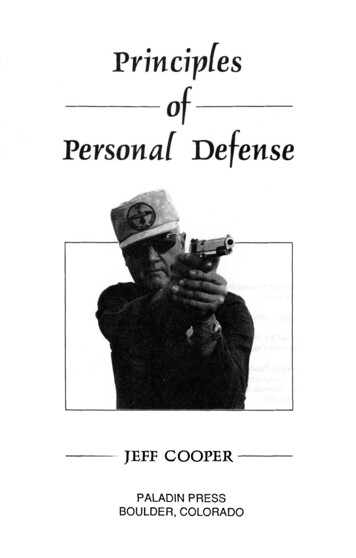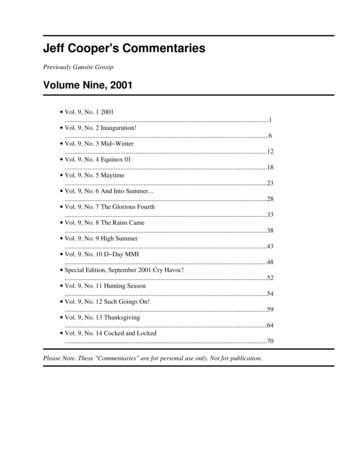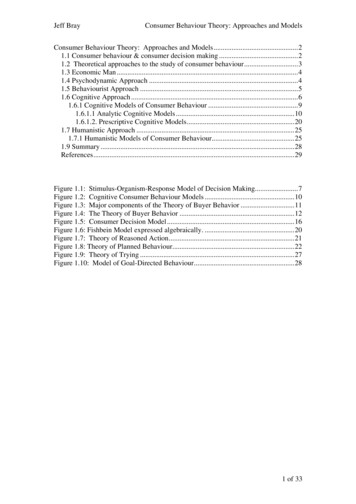
Transcription
JEFF COOPERPALADIN PRESSBOULDER, COLORADO
Principles of Personalby Jeff CooperCopyright 01989 by JISBN 0-87364-497-2Printed in the United SlPublished by Paladin PPaladin Enterprises, In Boulder, Colorado 8031(303) 443-7250Direct inquiries and/or orders to the above address.PALADIN, PALADIN PRESS, and the "horse head" designare trademarks belonging to Paladin Enterprises andregistered in United States Patent and Trademark Office.All rights reserved. Except for use in a review, noportion of this book may be reproduced in any formwithout the express written permission of the publisher.Neither the author nor the publisher assumesany responsibility for the use or misuse ofinformation contained in this book.
ContentsPreface . viiIntroduction . 1Principle One: Alertness.5Principle Two: Decisiveness .11Principle Three: Aggressiveness.17Principle Four: Speed.23Principle Five: Coolness.27Principle Six: Ruthlessness.33Principle Seven: Surprise .39A Final Word . 43
PrefaceIt is not common for one to enjoy rereading somethingthat he wrote a decade previously. Times change, styleschange, attitudes change, and most of all people grow, bothintellectually and emotionally. It is therefore with gratification and some little surprise that I was able to reread Principles of Personal Defense at the request of the publishers,and to discover that I felt no need to change anything ofimportance. It stands as it stood, and insofar as it spoke thetruth ten years ago, it speaks it still.The booklet is essentially a digest of a presentation Ideveloped while working in Central America before theCommunist takeover there. This part of the world has always been turbulent, and the need for individual selfdefense has remained fairly constant ever since the departure of the Spanish in the early part of the nineteenth century. Individual conduct in lethal confrontation is not,however, something that is confined to any one locale orera, and if there are principles guiding its conduct-and Ibelieve there are-those principles do not change accordingto geography, history, or sociological whim. If a principleexists it must be immutable, for that is what a principle isvll
a truth standing apart from the mood of the times.If I were to rewrite this pamphlet completely, the onlything I would change would be those few personal anecdotes that appear within it. I would update them to includeonly those that have taken place within the last year or so.As it now stands, the anecdotes are all at least ten years old,but the more I look at them, the more I realize that there isno need to change them, because the experiences that havemore recently come across my desk, and in which I havelately been involved, simply corroborate what has alreadybeen set down. These experiences could be rewritten toinclude nothing that happened more than one year ago andwe would have the same story. Thus it has not been necessary to do any extensive rewriting.To emphasize this point, however, I should mentionthat only this last week another episode came to my attention that was immensely satisfying in its exemplification ofseveral of the principles set forth in this work. It seems ayachtsman was asleep in his power cruiser docked in theBahamas. After midnight he opened one eye to be aware oftwo intruders in his cabin, one of whom was pointing aMini-14 at his chest from a range of about eighteen inches.This is a startling situation. This is an intimidating situation. It might properly be termed a terrifying situation. Butthe man remembered his principles and instantly attacked,with his hands, and won. He personified the principles ofdecisiveness, aggressiveness, speed, and surprise in a mostsatisfactory manner.Stories such as this come to my attention with such frequency that it would take a whole directory to list them.They establish beyond any question that the principles wehave taught over the decades, and still continue to teach atviii
Gunsite, are valid beyond any contradiction. Our work hereis conducted in order to keep the victims of aggressionalive, and the knowledge that it succeeds is our reward.Principles of Personal Defense has been received withonly moderate enthusiasm by the law enforcement establishment. Several departments have adopted it, but onlywith the deletion of the principles of aggressiveness andruthlessness. It obviously makes for bad press to have adepartment known as both aggressive and ruthless. This isquite understandable, but it does not invalidate the principles. In war there is no substitute for victory, and this isequally true of personal combat, which is, after all, amicrocosm of war. When a coward is offered deadly violence, his reaction may be to surrender, or cower, or flee, orcall for help; not one of these choices is likely to obviate hisperil.But this booklet was not written for cowards.I think it stands as well now as when it was first written,and I have nothing further to add to it.
IntroductionSome people prey upon other people. Whether we likeit or not, this is one of the facts of life. It has always beenso and it is not going to change. The number of sociopathsin a stipulated population varies widely, but we can take afigure of one in one hundred, for simplicity's sake, and notbe far off. About one person in one hundred will, undersome circumstances, initiate a violent attack upon another,in defiance of the law, for reasons that seem sufficient tohim at the time. Take the able-bodied male population ofyour community, divide it by one hundred, and you have afair approximation of the number of possible contacts whojust might take it upon themselves to beat your head in. It isnot pertinent to dispute the mathematics of this calculation.It may be wrong for your place and time. But anyone whois aware of his environment knows that the peril of physicalassault does exist, and that it exists everywhere and at alltimes. The police, furthermore, can protect you from it onlyoccasionally.The author assumes that the right of self-defense exists.Some people do not. This booklet is not for them. This isfor those who feel that anyone who chooses physically to
attack another human being does so at his peril. In somejurisdictions it is held that the victim of an attacker must,above all, attempt to escape. This is a nice legalistic concept, but it is very often tactically unsound. By the time onehas exhausted every means of avoiding conflict it may betoo late to save his life. Laws vary, and cannot be memorized encyclopedically; in any case, we are not concerned here about jurisprudence, but about survival. If onelives through a fight, we will assume that he is better offthan if he does not, even though he may be thereafterconfronted with legal action.Violent crime is feasible only if its victims are cowards.A victim who fights back makes the whole businessimpractical. It is true that a victim who fights back maysuffer for it, but one who does not almost certainly willsuffer for it. And, suffer or not, the one who fights backretains his dignity and his self-respect. Any study of theatrocity list of recent years-Starkweather, Speck, Manson,Richard Hickok and Cary Smith, et al-shows immediatelythat the victims, by their appalling ineptitude and timidity,virtually assisted in their own murders. ("Don't make themmad, Martha, so they won't hurt us.")Any man who is a man may not, in honor, submit tothreats or violence. But many men who are not cowards aresimply unprepared for the fact of human savagery. Theyhave not thought about it (incredible as this may appear toanyone who reads the paper or listens to the news) and theyjust don't know what to do. When they look right into theface of depravity or violence, they are astonished andconfounded. This can be corrected.The techniques of personal combat are not covered inthis work. The so-called "martial arts" (boxing, karate, the
stick, the pistol, etc.) are complete studies in themselvesand must be acquired through suitable programs of instruction, training, and practice. It behooves all able-bodied menand women to consider them. But the subject of this workis more basic than technique, being a study of the guidingprinciples of survival in the face of unprovoked violence onthe part of extralegal human assailants. Strategy and tacticsare subordinate to the principles of war, just as individualdefensive combat is subordinate to the following principlesof personal defense.
ALERTNESS
Principle One:Alertness"A commander may be forgiven for being defeated, butnever for being surprised." This maxim is among the first tobe impressed upon new lieutenants. It is equally applicableto individuals who aspire to a degree of physical security intoday's embattled society. Alertness is, to some extent, aninherent personality trait, but it can nonetheless be learnedand improved. Once we accept that our familiar and prosaicenvironment is in fact perilous, we automatically sharpenour senses.Two rules are immediately evident: Know what isbehind you, and pay particular attention to anything out ofplace.It is axiomatic that the most likely direction of attack isfrom behind. Be aware of that. Develop "eyes in the backof your head." Eric Hartmann, the World War I1 Germanflying ace who is unquestionably the greatest fighter pilotof all time (1,405 combat missions, 352 confirmed victories), feels that he survived because of an "extremelysensitive back to his neck"; and, conversely, claims that 80
percent of his victims never knew he was in the same skywith them. Combat flying is not the same as personaldefense, but the principle applies. The great majority of thevictims of violent crime are taken by surprise. The one whoanticipates the action wins. The one who does not, loses.Learn from the experience of others and don't let yourselfbe surprised.Make it a game. Keep a chart. Every time anyone isable to approach you from behind without your knowledge,mark down an X. Every time you see anyone you knowbefore he sees you, mark down an 0. Keep the 0 s ahead ofthe Xs. A month with no Xs establishes the formation ofcorrect habits.Observe your cat. It is difficult to surprise him. Why?Naturally his superior hearing is part of the answer, but notall of it. He moves well, using his senses fully. He is notpreoccupied with irrelevancies. He's not thinking about hisjob or his image or his income tax. He is putting first thingsfirst, principally his physical security. Do likewise.There are those who will object to the mood thisinstruction generates. They will complain that they do notwish to "live like that." They are under no obligation to doso. They can give up. But it is a feral world, and if onewishes to be at ease in it he must accommodate to it.Anything out of place can be a danger signal. Certainlyanyone you don't know approaching your dwelling must beregarded askance. It's ninety-nine to one that he is perfectlyharmless, but will you be ready if he turns out to be thatother one who is not?Certain things are obvious: an unfamiliar car parkedacross the street for long periods with people in it who donot get out; a car that maintains a constant distance behind
you while you vary your speed; young men in groups,without women, staying in one place and not talking. Thesethings should set off a first-stage alarm in anyone, but thereare many other signals to be read by the wary. Anyone whoappears to be triggered out of watchfulness and into actionby your appearance must be explained. Anyone observingyou carefully must be explained. Anyone whose behaviorseems to be geared to yours must be explained. If theexplanation does not satisfy you, be ready to take appropriate defensive action.A common ruse of the sociopath is the penetration of adwelling under false pretenses. Anyone can claim to be arepairman or an inspector of one sort or another. It is oftenimpractical to verify credentials, but merely being awarethat credentials may easily be falsified is protection againstsurprise. The strong need only remain watchful. The weakshould take further precautions.On the street, let no stranger take your hand. To allow apotential assailant a firm grip on your right hand is to givehim a possibly fatal advantage. Use your eyes. Do not enterunfamiliar areas that you cannot observe first. Make it apractice to swing wide around comers, use window glassfor rearward visibility, and get something solid behind youwhen you pause.All this may sound excessively furtive and melodramatic, but those who have cultivated what might becalled a tactical approach to life find it neither troublesomenor conspicuous. And, like a fastened seat belt, a life jacket,or a fire extinguisher, it is comforting even when unnecessary.Needless to say, no sensible person ever opens the doorof his house without knowing who is knocking. If your
entranceway does not permit visual evaluation of yourcaller, change it. The statistics may be against a threatwaiting outside, but statistics are cold comfort after youdiscover that your case is the rare exception.The foregoing suggestions are merely random examplesof ways in which the principle of alertness is manifested.Situations are numberless, and specific recommendationscannot be made to cover them all. The essential thing is tobear always in mind that trouble can appear at any time. Beaware. Be ready. Be alert.
DECISIVENESS
Principle Two:DecisivenessIt is difficult for a domesticated man to change in aninstant into one who can take quick, decisive action to meeta violent emergency. Most of us are unused to violentemergencies-especially those which can only be solved bythe use of force and violence on our part-and these emergencies requir
Preface It is not common for one to enjoy rereading something that he wrote a decade previously. Times change, styles change, attitudes change, and most of all people grow, both











